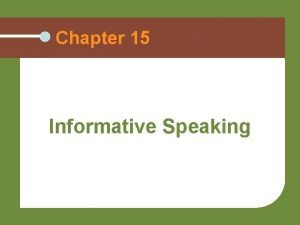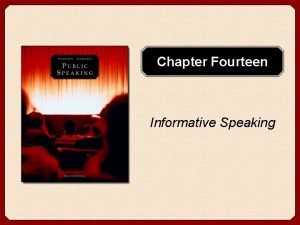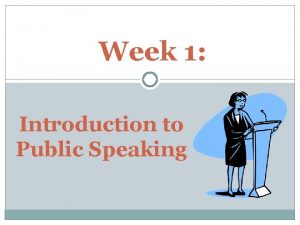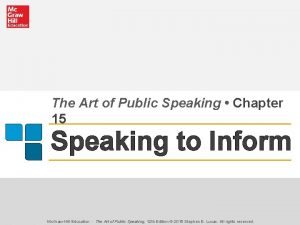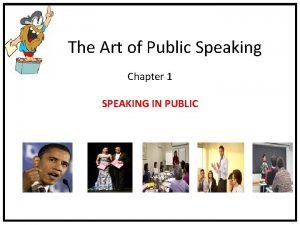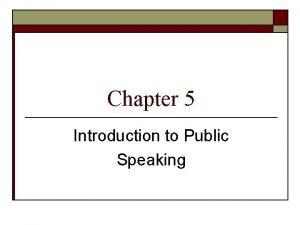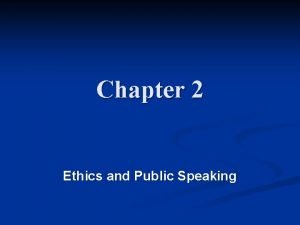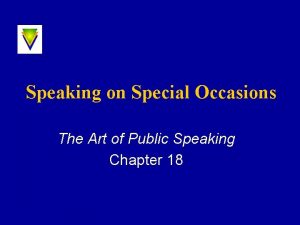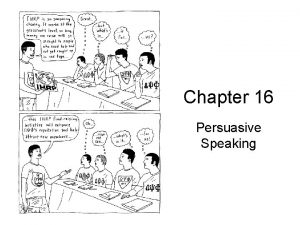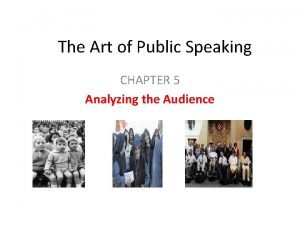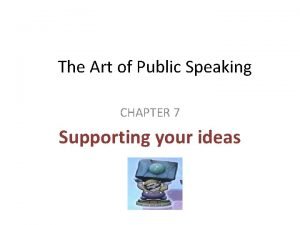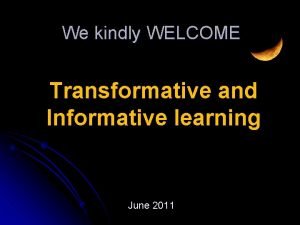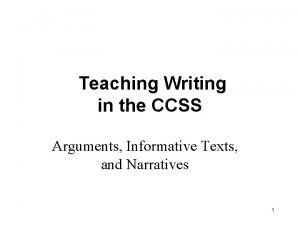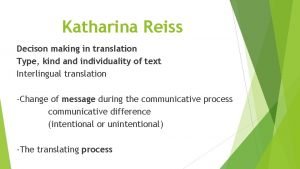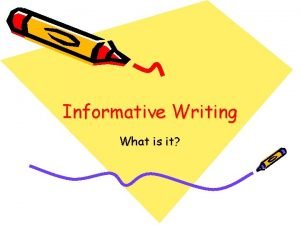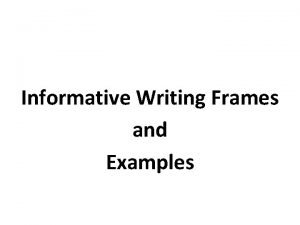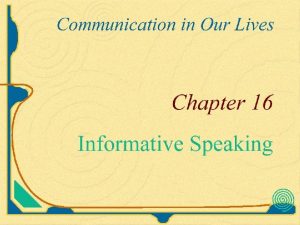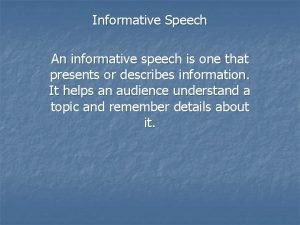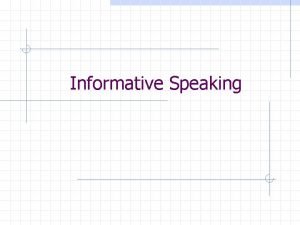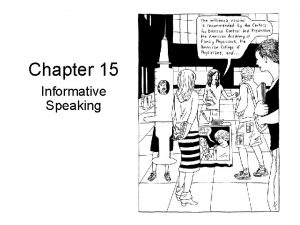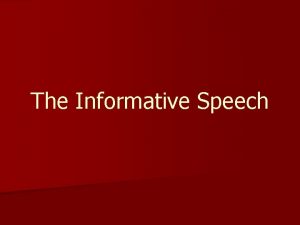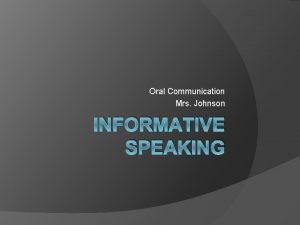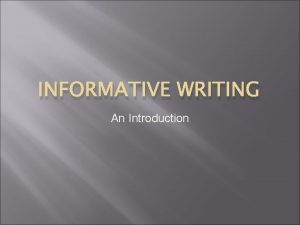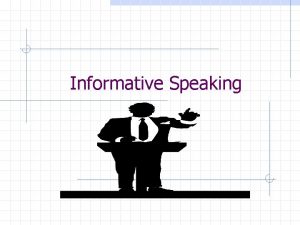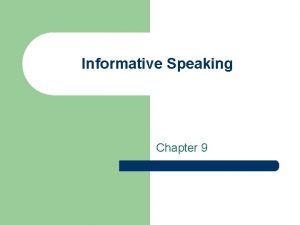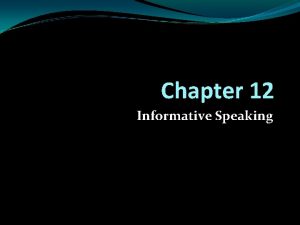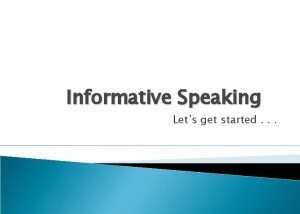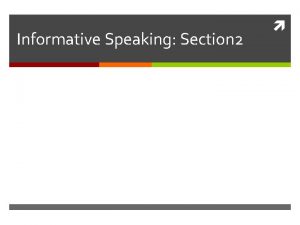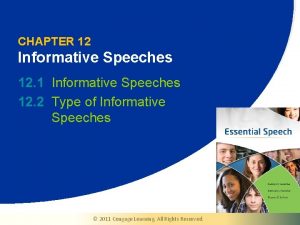Chapter 16 Informative Speaking Informative Speaking Introduction An






































- Slides: 38

Chapter 16 Informative Speaking

Informative Speaking: Introduction • An informative presentation: – Teaches the audience something – Increases listeners’ understanding, awareness, or sensitivity to your topic – May contain a bit of persuasive power

Techniques for Informing • Definition: Explains the essence, meaning, or purpose of something such as a/an: – Object – Person or group – Event – Process – Idea or concept

Techniques for Informing (cont. ) – Four types of definitions • Dictionary: presents the meaning of a term as it appears in a dictionary • Expert: comes from a credible source in the field • Etymological: traces the word or concept’s roots in the same or other languages • Functional: defines a concept by examining how it is applied or how it functions

Techniques for Informing (cont. )

Techniques for Informing (cont. ) • Explanation: Providing an analysis of something to clarify it, or tracing a line of causal connections between events – Works well on speeches that: • Present a process • Trace the end of an important event • Explain how an interesting object works

Techniques for Informing (cont. )

Techniques for Informing (cont. ) • Description: Using words to paint a mental picture for the listeners – Achieve maximum impact by using: • Vivid language • Presentation aids • Details that evoke the senses of sight, sound, smell, touch, and taste

Techniques for Informing (cont. ) • Demonstration: Teaching how a process or a set of guidelines works – Speaker uses both physical modeling (often with props) and verbal instruction to lead the audience through the demonstration – Requires confidence and practice – Aids learning and memory-enhancement, especially when coupled with repetition

Techniques for Informing (cont. )

Techniques for Informing (cont. ) • Narrative: A story used in an informative speech to both share information and capture the audience’s attention – Can take the form of a: • Personal remembrance • Humorous anecdote • Serious account of an event that happened in someone else’s life

Techniques for Informing (cont. ) – Used skillfully, narratives can help “humanize” a speaker and enhance credibility or ethos. – Select stories and details based on audience analysis. – Telling a compelling story in a way that also informs and educates is an art. • You want to come across as casual and natural, but also authoritative. • Requires preparation and practice.

Techniques for Informing (cont. )

Types of Informative Speeches • Objects – The one thing all objects have in common is that they are not human. – Objects suitable for an informative speech: • • Mechanical/technological Natural Cultural Personal

Types of Informative Speeches (cont. ) – Appropriate techniques for informative speeches about objects: • • Definition Explanation Demonstration Narrative – An informative speech about an object may also have elements of process in it.

Types of Informative Speeches (cont. ) • Individuals or groups – People are fascinated by human subjects. – Ideas include: • • A famous politician, sports star, explorer, or artist An unsung hero A tragic figure whose life provides a cautionary tale An influential political party, artistic movement, or musical group

Types of Informative Speeches (cont. )

Types of Informative Speeches (cont. )

Types of Informative Speeches (cont. ) – Techniques for a speech on a person or group: • Description • Narrative • Explanation – You can use life events to make a larger point about a person’s character. – A speech on a person or group might incorporate information about an object or process as well.

Types of Informative Speeches (cont. ) • Events – Notable or exceptional occurrences from the present or past – Consider events that your audience will find exciting, newsworthy, historically important, or interesting because they are unfamiliar or surprising. – Use narrative, description, or a blend of the two.

Types of Informative Speeches (cont. )

Types of Informative Speeches (cont. ) • Processes – A series of steps or stages that lead to a particular outcome – Informative speeches about processes can be at the micro or macro level. – Some processes are poor choices because of their sheer technical nature. • Focus on subject matter within your audience’s level of understanding. • Break the topic into smaller parts first.

Types of Informative Speeches (cont. ) – Walk the audience through the steps and their sequence. – You can use a variety of techniques, depending on your goal. – Avoid overused topics and topics related to alcohol. – Think about processes that would be interesting and fresh for your listeners. – Consider how you might discuss the impact of an important process.

Types of Informative Speeches (cont. ) • Ideas – Theory, principle, belief, or value – Relatively abstract – Some are loaded because people have difficulty agreeing on their meaning. – Select an idea carefully. • Consider listeners’ interests and level of education. • Ask if they have had prior exposure to the idea. • Consider how you might make an abstract idea more understandable.

Types of Informative Speeches (cont. )

Developing Your Informative Speech • Analyzing your audience – Focus on: • Where and how your audience is situated for the informative presentation • Your audience’s specific demographics • Any common ground between you and your audience

Developing Your Informative Speech (cont. ) • Selecting a technique – Consider which technique would most help you inform your audience about your topic: • • • Definition Explanation Description Demonstration Narrative Combination of techniques

Developing Your Informative Speech (cont. ) – Choice of technique helps you decide how to develop main points and supporting materials. – Consider audience size and details of the speaking forum when planning presentation aids. • For a small audience in a cramped space, showing objects or using handouts would be appropriate. • For a large audience in a large space, projecting Power. Point slides onto a large screen would be a better option.

Developing Your Informative Speech (cont. )

Developing Your Informative Speech (cont. ) • Focusing on Your Goal to Inform – Remain focused on your rhetorical purpose at every phase. – If you know your subject well enough not to have to do research, establish your own credentials. – Remember your responsibility to remain objective.

Clarifying and Simplifying Your Message • Strive for clarity in every informative speech, no matter what your topic is or who your listeners are. • Audience analysis – Will help you decide how much you should simplify your informative speech

Clarifying and Simplifying Your Message (cont. ) • Techniques for clarifying or simplifying complex messages – Move from general to specific.

Clarifying and Simplifying Your Message (cont. ) – Reduce the quantity of information you present. • Look for ways to pare down details.

Clarifying and Simplifying Your Message (cont. ) – Make complex information seem familiar. • Use definition to explain difficult-to-follow terms and ideas, and avoid jargon.

Clarifying and Simplifying Your Message (cont. ) – Use presentation aids.

Clarifying and Simplifying Your Message (cont. ) – Reiterate your message. • Refer to the complex message several times, but with different words each time.

Clarifying and Simplifying Your Message (cont. ) – Repeat your message. • Conveying a key point several times using the same words can help ensure listeners understand your message.

Sample Informative Speech • Rachel Parish, “Spider Silk: A Miracle Material Derived from. . . Goats? ” – Read the sample speech with comments in your textbook. – Three main points: • Background and unique properties of spider silk • Role of the “spider goat” in producing spider silk • Current and future uses of spider silk
 The goal of informative speaking is
The goal of informative speaking is Uil extemp topics
Uil extemp topics Characteristics of effective informative speaking
Characteristics of effective informative speaking What is the essence of informative speaking
What is the essence of informative speaking The art of public speaking chapter 1 review questions
The art of public speaking chapter 1 review questions How do you write an informative essay
How do you write an informative essay The art of public speaking chapter 15
The art of public speaking chapter 15 Chapter 16 speaking to persuade
Chapter 16 speaking to persuade Chapter 1 speaking in public
Chapter 1 speaking in public Public speaking chapter 5
Public speaking chapter 5 Presenting another person's language or ideas as one's own.
Presenting another person's language or ideas as one's own. Public speaking chapter 1
Public speaking chapter 1 Commerative speech
Commerative speech Existential statement example sentence math
Existential statement example sentence math Value persuasive speech
Value persuasive speech The art of public speaking chapter 4
The art of public speaking chapter 4 The art of public speaking chapter 7
The art of public speaking chapter 7 Body paragraph structure
Body paragraph structure Informative abstract example
Informative abstract example How is a consumer document an informational text
How is a consumer document an informational text Informative paragraph
Informative paragraph Informative learning
Informative learning Informative expressive operative
Informative expressive operative Surprising reversal strategy
Surprising reversal strategy Ce înseamnă text informativ
Ce înseamnă text informativ Informative texts definition
Informative texts definition Informative essay hooks
Informative essay hooks Informative essay outline
Informative essay outline Modes of exposition
Modes of exposition Informative abstract example
Informative abstract example Informative expressive operative
Informative expressive operative Success criteria for informative writing
Success criteria for informative writing Informative writing definition
Informative writing definition Information text examples
Information text examples Informative vs persuasive
Informative vs persuasive Informative speech examples
Informative speech examples Specific purpose statement for an informative speech
Specific purpose statement for an informative speech Informative speech rubric
Informative speech rubric Informative speech vs persuasive speech
Informative speech vs persuasive speech
